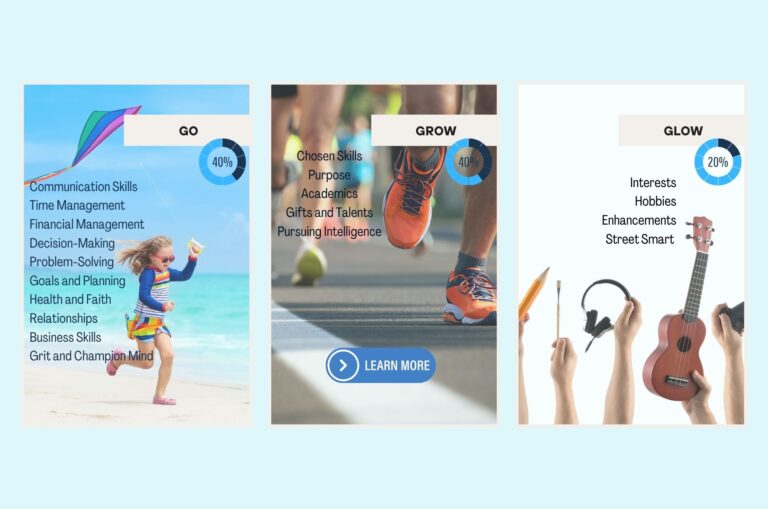Three Simple Steps to Energize Your Home Learning
We understand the challenges that come with learning from home. The process can often feel overwhelming and daunting, but fear not, for we are here to guide you through it. Our aim is to simplify this experience for you, so we have distilled it down to three simple and actionable steps. In the next few minutes, we urge you to approach this with an open mind and a willingness to embrace change. With our carefully crafted three-step approach, get ready to embark on a transformative journey that will revolutionize your learning experience from the comfort of your own home.

Step 1: Embrace the Shift from School to Lifelong Learning
While schools often prioritize achievement and test scores, true learning stems from acquiring practical skills through hands-on, real-life experiences. Although academic success is highly valued, we are dedicated to ensuring that our children are not confined by their test results. Our focus lies in empowering each child to apply academic concepts to their daily lives, fostering a well-rounded and practical approach to education.
A school is a place of structure and organization, providing a supportive environment for learning. However, while this structure offers guidance, it is important to also allow room for individual exploration and freedom in the pursuit of knowledge. For instance, the traditional rule of the school year being at least one hundred eighty (180) days, Monday to Friday, for at least six hours a day, may unintentionally confine the concept of learning to those specified hours. This restriction can limit a child’s natural curiosity and enthusiasm for learning beyond the classroom. Additionally, it leaves little time for pursuing non-academic interests and discovering individual talents. Embracing a flexible approach to education would allow children to explore and nurture their unique abilities, thus bridging their academic knowledge with real-life experiences.
With this first step, allow yourself to dream. Ask yourself questions about what you would like your child to learn, and how you would like them to learn. Imagine a learning space where there is freedom, unrestricted by time or walls. Scheduling a trip or vacation during this unschooling process allows you to see what is outside of the box. So give yourself plenty of time for this process. This process is most effective when done with the entire family. After all, it is your home, and each one is part of it.
Step 2: Embrace Your Child’s Uniqueness
When I made the decision to homeschool our children, I quickly realized that I didn’t know them as well as I thought I did. As a result, our first few days of homeschooling were challenging, filled with grumpiness and more meltdowns than I could count. I found myself simply reading through the lesson plan like a robot, while my child looked at me with a puzzled expression. I’m sure she wondered if I had completely lost my mind. Does this sound familiar to you?
I’ve come to realize that we have the opportunity to catch up and ensure a bright future for my children. Pausing their formal education was a difficult decision, but it allowed me to truly understand their individual strengths and interests. By embracing their natural curiosity, I gained valuable insights that will guide our journey forward.
One of the activities I fondly remember was collecting acorns. It may have seemed like a simple activity, but it provided valuable insights into my children’s unique interests. One of them showed a keen curiosity for the squirrels that relied on the acorns, while the other was more focused on counting our collection. This experience helped me recognize the distinctive characteristics of an animal-conscious child versus a logically-inclined one. Engaging in outdoor activities allowed me to effortlessly introduce important concepts they needed to learn, without coming across as rigid or robotic. Most importantly, it deepened my understanding of each child’s individuality.
Brainstorming with your children can often lead to unexpected insights and provide a window into their thoughts and perspectives. It can create valuable opportunities for open communication and a chance to understand their unique viewpoints. Whether it’s during shared meals, car rides, or family gatherings, spontaneous discussions can foster a sense of connection and deepen your understanding of your children. Daily walks provide a relaxed setting for contemplative conversations, allowing ideas to flow freely. By initiating discussions and observing their responses, you can gain valuable insights into their interests, concerns, and evolving personalities. This approach can strengthen your bond with your children and create memorable moments of shared discovery.
I also particularly enjoy board games. These games can bring out the competitive spirit and character in individuals. The variety of traits that come to light during gameplay is truly fascinating: patience, sportsmanship, logical and critical thinking, and more. Most importantly, playing board games can provide valuable insight into how people learn. Observing whether they prefer to learn by reading the instructions, learning as they play, or learning by observing first is an enriching experience.
Once you have a good understanding of your child’s daily activities, teaching and learning with your child will become effortless. Every day will transform into a valuable learning opportunity for both of you.
Step 3: Empower Your Child with Personalized Learning Goals
With the freedom of unschooling already in place, and your deep understanding of your child’s unique learning style, you’ll naturally empower your child with personalized learning goals. This isn’t a one-time event, but an ongoing journey as you continue to discover more about your child. While setting goals for the first time may involve some trial and error, it will become easier as you deepen your understanding of your child. Taking this step to set individualized goals for each child will bring tremendous benefits. Keep in mind that every child learns differently, making it essential to create a personalized plan for each one.
Before you choose a curriculum, think about what you want to achieve. This will help you save money because you won’t have to buy materials that your child won’t benefit from. Consider your child’s learning style when looking for a curriculum. You can even use a combination of different curricula. Choose a curriculum that matches how your child learns. Remember, there are also many free homeschooling resources available.
If your child is mature enough, you can certainly collaborate with them to discover what they would like to accomplish.
The development of non-academic skills is also crucial! It’s beneficial to take them into account when establishing your objectives, and they may even arise later in the year. Sometimes, creative ideas just spring to mind! This is where a touch of creativity can really make a difference. While it’s important to allocate specific time (e.g. 3 hours a day) to academic learning, it’s also valuable to think about how to apply the knowledge gained in everyday life experiences and skills. Your child will value this even more when they see academic learning being put into practice in their daily lives. This can be achieved through field trips (especially for History and Sciences), as well as through board games (for Math and Language Arts). It can be as simple as a trip to the grocery store (involving money), baking (involving measurements), shopping (using percentages for discounts), or even playing video games (involving strategy). The key is to help them comprehend why they need to learn academically by enabling them to apply these concepts to their daily lives through real experiences.
Formal non-academic learning encompasses a wide array of valuable skills and knowledge that extend beyond traditional scholarly subjects. It includes areas such as music, arts, foreign languages, leadership, book writing, typewriting, technology, and so much more. Engaging in these diverse areas of study can greatly enrich one’s personal and professional life. For instance, delving into the world of music not only hones one’s artistic abilities but also fosters discipline and perseverance. Meanwhile, mastering a foreign language not only opens doors to new cultures and communication but also enhances cognitive abilities. Leadership skills, coupled with effective communication, can empower individuals to inspire and guide others to achieve common goals. The art of book writing not only allows individuals to express their creativity but also enables them to share meaningful stories and ideas with the world. Typewriting proficiency, although often overlooked, remains an essential skill in today’s digital age, enhancing efficiency and productivity. Furthermore, technology literacy lays the foundation for success in numerous fields, given its omnipresence in modern society.Embracing formal non-academic learning presents boundless opportunities for personal development and growth, equipping individuals with a versatile skill set that transcends traditional academic boundaries.


![Family reading together with title 9 Homeschooling Mistakes to avoid [2024] from my experience.](https://homeschooldomination.com/wp-content/uploads/2024/02/Homeschool-Domination.CommonMistake.02-768x432.jpg)



